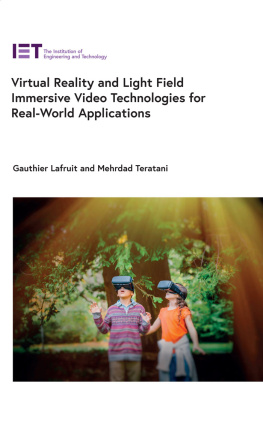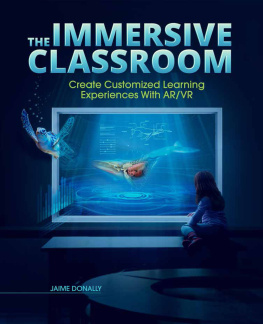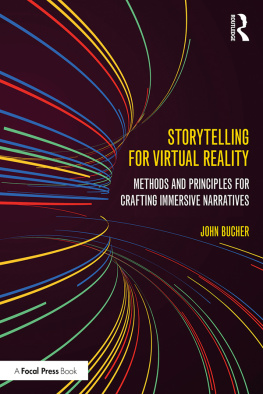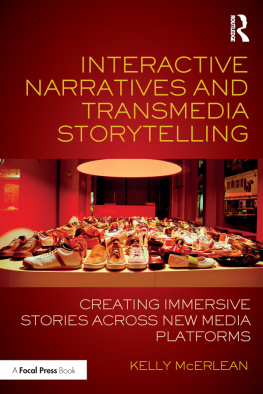Contents
Guide
Pagebreaks of the print version
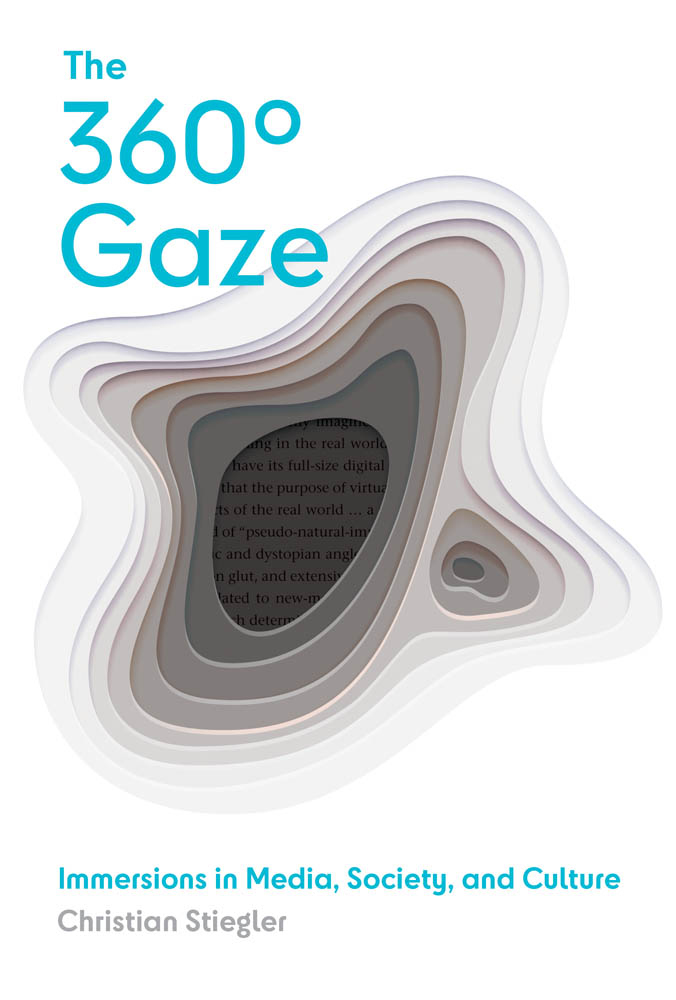
The 360 Gaze
Immersions in Media, Society, and Culture
Christian Stiegler
The MIT Press
Cambridge, Massachusetts
London, England
2021 Massachusetts Institute of Technology
All rights reserved. No part of this book may be reproduced in any form by any electronic or mechanical means (including photocopying, recording, or information storage and retrieval) without permission in writing from the publisher.
Library of Congress Cataloging-in-Publication Data
Names: Stiegler, Christian, 1981 author.
Title: The 360 gaze : immersions in media, society, and culture / Christian Stiegler.
Other titles: Three hundred and sixty degree gaze
Description: Cambridge, Massachusetts : The MIT Press, [2021] | Includes bibliographical references and index.
Identifiers: LCCN 2020025426 | ISBN 9780262045667 (hardcover)
Subjects: LCSH: Virtual reality--Social aspects. | Virtual reality in literature. | Motion pictures--Plots, themes, etc. | Video games.
Classification: LCC HM851 .S7485 2021 | DDC 303.48/33--dc23
LC record available at https://lccn.loc.gov/2020025426
d_r0
Contents
List of Figures
Black Mirrors Nosedive, Playtest, and San Junipero: immersive experiences with the help of various digital technologies. Reprinted with the permission of Netflix. 2016 Netflix.
Alices Adventures in Wonderland and Ready Player One: falling down the rabbit hole and putting on the VR headset. Reprinted with the permission of Jaap Buitendijk/Warner Bros. Pictures. 2020 Arthur Rackham/CC BY and 2018 by Jaap Buitendijk/Warner Bros. Pictures.
Facebook CEO Mark Zuckerberg at the Mobile World Congress in Barcelona, 2016. Reprinted with the permission of Facebook. 2016 Facebook.
Facebook Horizon: Facebooks newest try at a social VR app. Reprinted with the permission of Facebook. 2020 Oculus.
The Harry Potter Studio Tour in Leavesden, UK: visitors in front of the massive wooden door that leads to Hogwarts Great Hall. 2012 the author.
Facebook Spaces: a virtual birthday party creates real memories. Reprinted with the permission of Facebook. 2017 Facebook.
Platform 9: Visitors pretend to jump into the magic brick wall to catch the Hogwarts Express. Reprinted with the permission of National Rail and Kings Cross. 2012 John Sturrock.
The 360 gaze. 2020 by the author.
Caspar David Friedrichs Wanderer above the Sea of Fog: the disappearance of the window-like image space. 2020 CC BY.
Jonathan Safran Foers Tree of Codes experiments with die-cutting techniques. Reprinted with the permission of Visual Editions. 2010 Visual Editions.
Alices Adventures Underground: the White Rabbit performs in Londons Waterloo station. Reprinted with the permission of Les Enfants Terribles. 2017 Fiona Porritt.
A Lot of Sorrow: for Ragnar Kjartanssons immersive installation, the American band The National played their song Sorrow continuously for six hours at MoMA PS1. Reprinted with the permission of the artist, Luhring Augustine, New York, and i8 Gallery, Reykjavik. 2013 Elisabet Davids.
Bjrks Mouth Mantra: inside the singers mouth. Reprinted with the permission of Prettybird and One Little Independent Records. 2016 Prettybird and One Little Independent Records.
Xiaomis futuristic Mi MIX Alpha phone: the screen curves over its boundaries and wraps around the whole phone. Reprinted with the permission of Xiaomi. 2019 Xiaomi.
Hardcore Henry: the visceral thrill of taking on a first-person perspective. Reprinted with the permission of Huayi Brothers Pictures, Bazelevs Productions, and Versus Pictures. 2015 Huayi Brothers Pictures, Bazelevs Productions, and Versus Pictures.
Pokmon Go: the AR game positions virtual characters in real-world settings. 2016 Dalton White, CC BY.
Draw Me Close: getting tucked in by Mother in VR. Reprinted with the permission of the National Film Board of Canada and the Royal National Theatre. 2019 Ellie Kurttz for the National Film Board Canada and the Royal National Theatre.
Facebook Horizon: the appearance of digital avatars in VR. Reprinted with the permission of Facebook. 2020 Oculus.
Netflixs Stranger Things: the boys wearing Ghostbusters costumes for Halloween. Reprinted with the permission of Netflix. 2017 Netflix.
Go Binge: British telecommunication provider Three uses Netflix and binge-watching to attract customers on their commute. 2018 the author.
Unbreakable Kimmy Schmidt: Kimmy vs. the Reverend: Netflix experiments with the structure of interactive storytelling. Reprinted with the permission of Netflix. 2020 Netflix.
iPhone X users can send AR-animated emoji that mirror their facial expressions. Reprinted with the permission of Apple. 2017 Apple.
Ed Atkins: Ribbons: the creation of digital vessels. The body is no longer the bastion of authenticity. Reprinted with the permission of the artist. 2014 Ed Atkins.
Mark Zuckerberg revisits Facebooks 10-year roadmap at the F8 developer conference in 2018. Reprinted with the permission of Facebook. 2018 Facebook.
The Sex Robots Are Coming: James and the AI-enabled sex robot Harmony. Reprinted with the permission of Raw TV and Channel 4. 2017 Raw TV and Channel 4.
List of Table
Acknowledgments
Immersion always begins with the self.
At the age of 15, I went through a particularly difficult period in my life. Like many teenagers, I felt alone, unloved, and never to be kissed. Nothing seemed to really fit: the school I was in, the clothes I wore, the girls I dated. In the years of my teenage vulnerabilities I began to isolate myself from the world around me, and I lost myself in music. Quite a lot of music, actually. Endless hours, every day. I spent most of my time hiding in the attic of my parents house, eating cherries and listening to records by Patti Smith, Bob Dylan, David Bowie, Peter Gabriel, Elliott Smith, and Bruce (The Boss) Springsteen.
At that time, I discovered R.E.M. The four-piece band from Athens, Georgia, got me at my most vulnerable. And boy, did I need them. Not only did they become the nucleus of my indie-rock and pop-culture universe, but I would even go so far as to admit that they have significantly shaped my personality. I was fascinated by their modesty, their charismatic quirks, and the way they handled their fame. They set the template for many guitar-based bands to follow, from Nirvana to Radiohead, Arcade Fire, and The National.
Over the course of two decades, I think it is safe to say that I became a hardcore fan. I have seen them 17 times in concerts all around the world, interviewed them on three occasions in my role as a music journalist, collected over two hundred band-related itemsin what I call my R.E.M. shrineand met several other fans over the years who became dear friends of mine. Whenever I was in love, I always made my partner an R.E.M. mixtapenot to convert her to my devotion, but to give her something that meant a great deal to me. Whenever I had a job interview and needed to introduce myself, the last sentence has always been: I am also a big fan of R.E.M. That statement may not have seemed particularly revealing, but in fact it was. That I was in love with this particular band probably said more about my personality than any CV or reference letter ever could. In 2011, when R.E.M. called it a day, the amicable way the three remaining members Peter Buck, Mike Mills, and Michael Stipe walked away from their careers was as inspiring to me as everything else they did.




